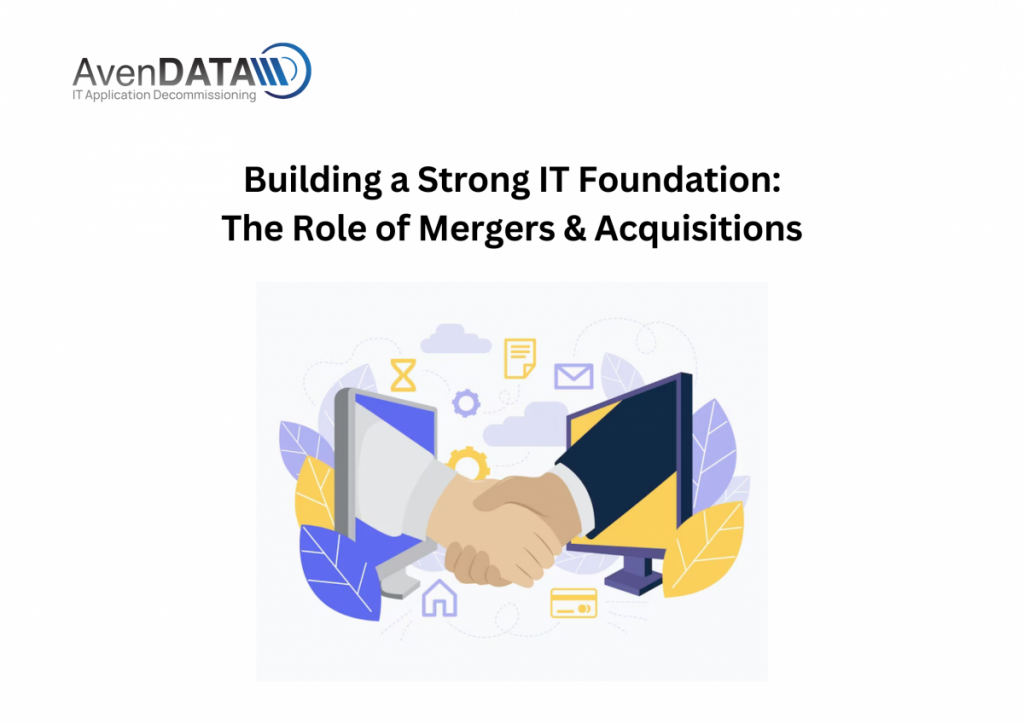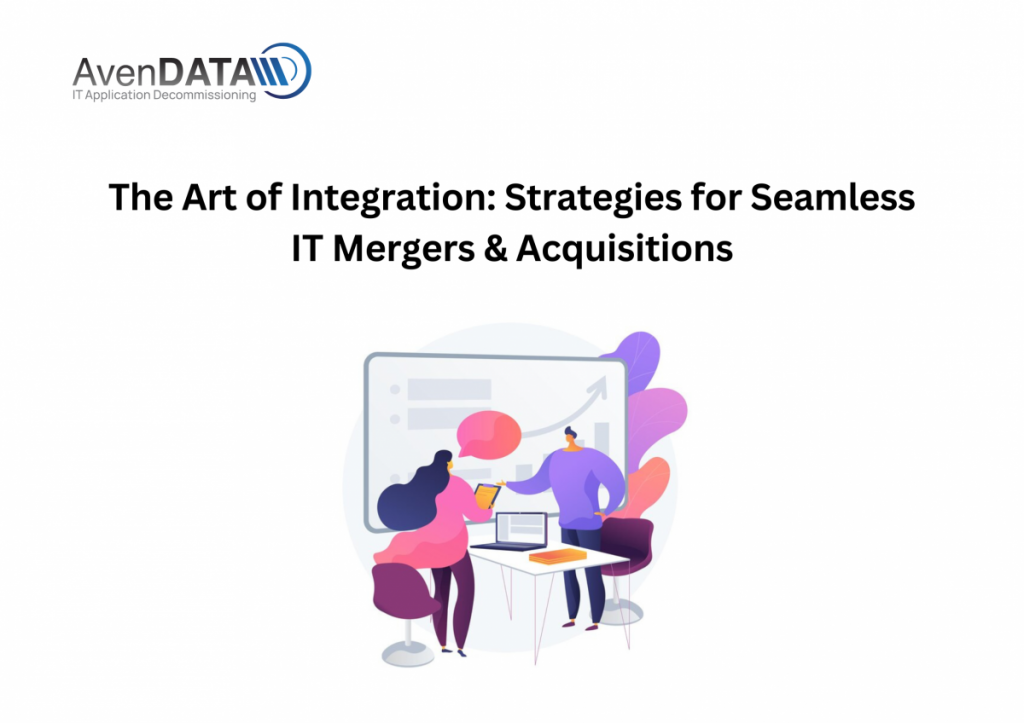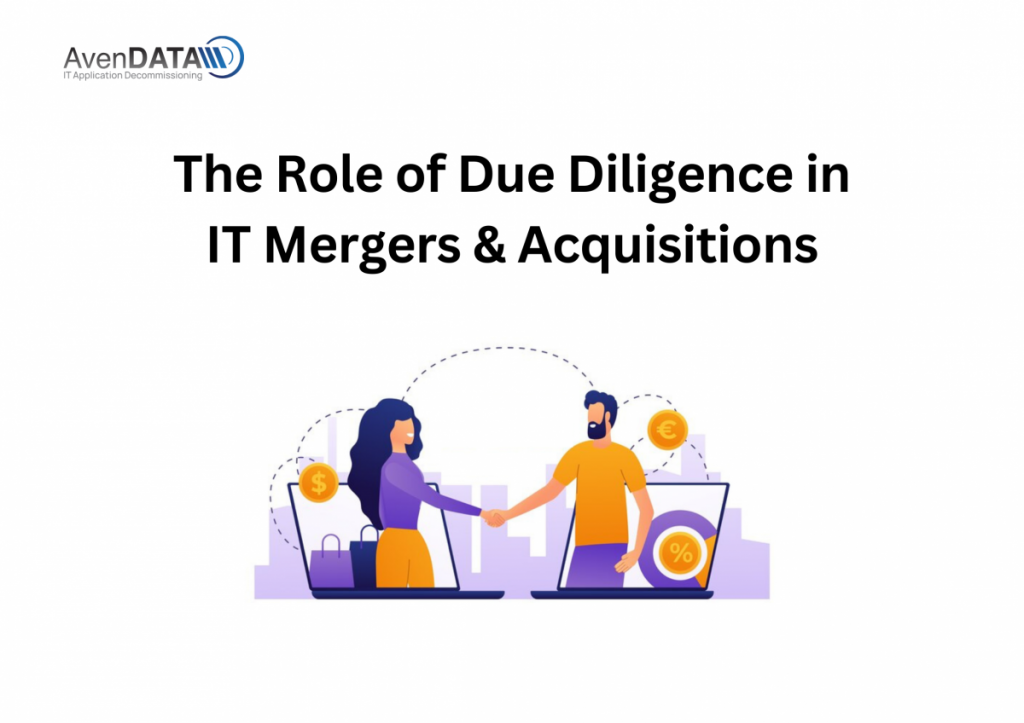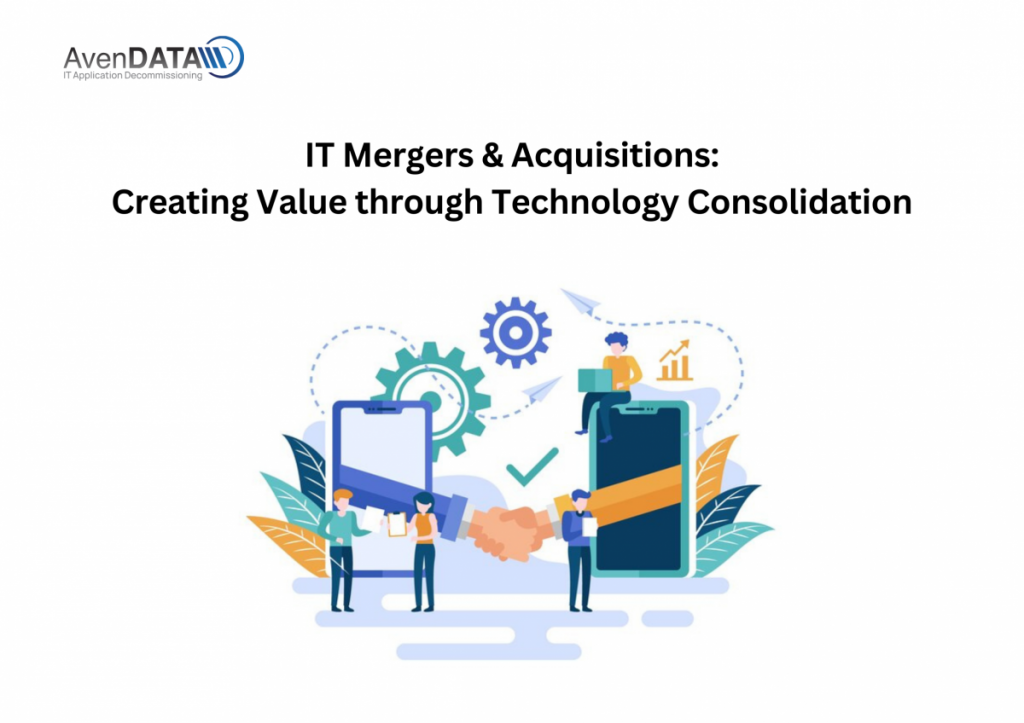IT Mergers & Acquisitions: Driving Efficiency and Cost Optimization
Introduction: In today’s competitive business landscape, organizations are constantly seeking ways to improve efficiency and opti... View MoreIT Mergers & Acquisitions: Driving Efficiency and Cost Optimization
Introduction: In today’s competitive business landscape, organizations are constantly seeking ways to improve efficiency and optimize costs. Mergers and acquisitions (M&A) have emerged as powerful strategies to achieve these objectives, particularly in the realm of IT. This blog explores how IT M&A can drive efficiency and cost optimization, outlining key considerations, benefits, and challenges organizations face in this transformative process.
Consolidating IT Infrastructure: One of the primary drivers of efficiency and cost optimization in IT M&A is the consolidation of IT infrastructure. By merging or acquiring companies, organizations can streamline their IT operations, eliminate redundancies, and optimize resources. This consolidation enables the integration of systems, applications, and networks, resulting in improved efficiency and reduced costs.
Achieving Economies of Scale: IT M&A allows organizations to achieve economies of scale, leading to increased efficiency and cost savings. By combining resources, purchasing power, and negotiating contracts with vendors, organizations can benefit from volume discounts and more favorable terms. This scaling effect helps optimize costs across various IT functions, including software licensing, hardware procurement, and data center operations.
Standardizing Processes and Workflows: The integration of IT systems and processes during M&A provides an opportunity to standardize workflows and eliminate inefficiencies. By implementing consistent processes and best practices across the merged entities, organizations can reduce duplication, improve collaboration, and enhance operational efficiency. Standardization also facilitates better resource allocation and reduces the need for redundant IT roles and functions.
Leveraging Shared Services: IT M&A allows organizations to leverage shared services, resulting in cost optimization and improved efficiency. By centralizing common IT functions such as help desk support, infrastructure management, cybersecurity, and application development, organizations can eliminate duplication, streamline processes, and leverage specialized expertise. Shared services enable resource pooling, knowledge sharing, and overall cost reduction.
Rationalizing Application Portfolio: M&A presents an opportunity to rationalize the application portfolio, optimizing costs and improving efficiency. By assessing and consolidating software applications, organizations can eliminate redundant or underutilized systems, simplify maintenance, and reduce licensing and support costs. This rationalization allows for a leaner, more efficient application landscape that better aligns with business needs.
Optimizing Vendor Relationships: IT M&A provides organizations with an opportunity to optimize vendor relationships and contracts. By consolidating vendor portfolios, organizations can negotiate better terms, reduce costs, and improve service levels. Rationalizing vendor relationships also enables organizations to focus on strategic partnerships, leveraging the expertise and capabilities of select vendors to drive efficiency and innovation.
Challenges and Considerations: While IT M&A offers significant benefits, organizations must navigate several challenges to drive efficiency and cost optimization:
Cultural Integration: Merging different organizational cultures can pose challenges to achieving efficiency and cost optimization. Organizations must focus on fostering open communication, promoting collaboration, and aligning values and goals to ensure a smooth integration of people and processes.
Data Integration and Management: Consolidating data from different systems requires careful planning and execution. Organizations must address data integrity, quality, and compatibility issues to ensure accurate and efficient data management post-merger.
Change Management: Managing change effectively is crucial to driving efficiency and cost optimization. Clear communication, employee engagement, and comprehensive change management strategies are vital in navigating organizational transitions and minimizing disruptions.
IT Governance and Risk Management: M&A can impact IT governance and risk management frameworks. Organizations must assess and align governance structures, policies, and risk management practices to ensure compliance, mitigate risks, and drive efficiency.
Conclusion: IT Mergers and Acquisitions offer organizations a significant opportunity to drive efficiency and cost optimization in their IT operations. By consolidating IT infrastructure, achieving economies of scale, standardizing processes, leveraging shared services, rationalizing the application portfolio, and optimizing vendor relationships, organizations can streamline operations, eliminate redundancies, and reduce costs. Effective management of cultural integration, data integration, change, and IT governance challenges is crucial for successful implementation. By embracing these considerations, organizations can harness the transformative power of IT M&A to achieve enhanced efficiency, cost optimization, and sustained competitive advantage in the dynamic business landscape.
Know more : https://avendata.com/mergers-acquisitions
#AvenDATA #legacysystems #ITlegacysystems #ITmergers #ITAcquisitions #mergersandacquisitions #datamigration
Building a Strong IT Foundation: The Role of Mergers & Acquisitions
Introduction: In today’s rapidly evolving digital landscape, organizations are constantly seeking ways to build a strong and comp... View MoreBuilding a Strong IT Foundation: The Role of Mergers & Acquisitions
Introduction: In today’s rapidly evolving digital landscape, organizations are constantly seeking ways to build a strong and competitive IT foundation. Mergers and acquisitions (M&A) have emerged as a strategic approach to achieve this objective. This blog explores the role of M&A in building a robust IT foundation and highlights key considerations, benefits, and challenges that organizations face in this transformative process.
Access to New Technologies and Capabilities: M&A provides organizations with an opportunity to gain access to new technologies and capabilities that can strengthen their IT foundation. By acquiring companies with innovative solutions or expertise in emerging fields, organizations can enhance their product offerings, improve operational efficiency, and stay ahead of the competition.
Scaling IT Infrastructure and Resources: M&A enables organizations to scale their IT infrastructure and resources quickly. By acquiring companies with established IT infrastructure, including data centers, servers, and networks, organizations can expand their capacity and capabilities without significant upfront investments. This scalability allows for increased agility and the ability to meet growing demands effectively.
Broadening Market Reach: M&A provides organizations with an avenue to expand their market reach and customer base. By acquiring companies with complementary products or services, organizations can diversify their offerings and tap into new markets. This expansion not only strengthens the IT foundation but also creates opportunities for revenue growth and increased market share.
Accelerating Innovation and R&D: M&A can facilitate the acceleration of innovation and research and development (R&D) efforts. By acquiring companies with a strong focus on R&D or specialized expertise, organizations can leverage their capabilities to drive innovation and develop cutting-edge solutions. This enables organizations to stay at the forefront of technology advancements and maintain a competitive edge.
Talent Acquisition and Retention: M&A provides organizations with an opportunity to acquire top talent. By merging with or acquiring companies that have a skilled workforce, organizations can strengthen their IT foundation by adding expertise and domain knowledge. Retaining key employees through effective talent management strategies is crucial in ensuring a smooth integration and maximizing the value of the acquired talent.
Streamlining Processes and Operations: M&A can streamline processes and operations, leading to improved efficiency and cost savings. By integrating systems, applications, and workflows, organizations can eliminate redundancies, optimize resources, and standardize processes. This streamlining enhances the IT foundation by creating a unified and cohesive operational structure.
Challenges and Considerations: While M&A offers numerous benefits, organizations must navigate several challenges during the process of building a strong IT foundation.
Cultural Integration: Merging different organizational cultures can be complex. It is crucial to foster open communication, promote collaboration, and align values and goals to ensure a smooth integration of people and processes.
IT Infrastructure Integration: Consolidating IT infrastructure from different organizations requires careful planning and execution. Ensuring compatibility, data migration, and minimizing disruptions are key considerations in this process.
Data Security and Privacy: Merging IT systems and databases brings forth data security and privacy concerns. Organizations must assess and address potential vulnerabilities, implement robust cybersecurity measures, and comply with data protection regulations.
Change Management: Managing change effectively is essential to overcome resistance and ensure a smooth transition. Clear communication, employee engagement, and comprehensive change management strategies are vital in building a strong IT foundation.
Conclusion: Mergers and acquisitions play a pivotal role in building a strong IT foundation for organizations. By leveraging M&A, organizations can access new technologies, scale their IT infrastructure, broaden their market reach, accelerate innovation, and acquire top talent. However, organizations must also address challenges such as cultural integration, IT infrastructure consolidation, data security, and change management. By considering these factors and implementing effective strategies, organizations can successfully build a robust IT foundation that drives growth, innovation, and long-term success in the evolving digital landscape.
Know more : https://avendata.com/mergers-acquisitions
#AvenDATA #legacysystems #ITlegacysystems #ITmergers #ITAcquisitions #mergersandacquisitions #datamigration
IT Mergers & Acquisitions: A Strategic Approach to Market Expansion
Introduction: In the dynamic landscape of the technology industry, mergers and acquisitions (M&A) serve as strategic vehicles for o... View MoreIT Mergers & Acquisitions: A Strategic Approach to Market Expansion
Introduction: In the dynamic landscape of the technology industry, mergers and acquisitions (M&A) serve as strategic vehicles for organizations to expand their market presence, bolster their capabilities, and capitalize on synergies that drive growth and innovation. The realm of IT mergers and acquisitions represents a compelling avenue for market expansion, enabling entities to cultivate competitive advantages, enhance their offerings, and position themselves as leaders in the ever-evolving digital marketplace. This blog aims to explore the strategic approach to market expansion through IT mergers and acquisitions, shedding light on the transformative potential, key considerations, and best practices that underpin successful M&A endeavors in the IT sector.
Strategic Market Positioning: IT mergers and acquisitions provide organizations with an opportunity to strategically position themselves within target markets, industry segments, and emerging technology domains. Through targeted acquisitions or mergers with complementary entities, organizations can expand their market footprint, gain access to new customer segments, and diversify their portfolio of products and services. This strategic market positioning enables entities to fortify their competitive standing and capitalize on the synergies that arise from complementary capabilities and resources.
Access to Specialized Expertise: Market expansion through IT mergers and acquisitions facilitates access to specialized expertise, technical talent, and domain knowledge that augments organizational capabilities. By acquiring entities with niche expertise, proprietary technologies, or innovative solutions, organizations can enhance their depth of offerings, accelerate product development, and cultivate a competitive edge in specialized market segments. The integration of specialized expertise obtained through M&A transactions empowers organizations to address evolving market demands and pursue strategic initiatives with confidence.
Accelerated Innovation and Digital Transformation: M&A transactions in the IT sector serve as catalysts for accelerated innovation and digital transformation, fostering the integration of cutting-edge technologies, digital platforms, and intellectual property. By combining R&D efforts, innovation pipelines, and technology roadmaps, merging entities can amplify their innovation capabilities, expedite time-to-market for new solutions, and drive digital transformation initiatives that resonate with evolving customer needs and market trends. Market expansion through IT M&A fuels a culture of innovation and agility that propels organizations towards sustained growth and relevance.
Synergistic Resource Optimization: The strategic approach to market expansion through IT mergers and acquisitions hinges on the optimization of synergistic resources, including IT infrastructure, data assets, intellectual property, and operational efficiencies. Merging entities can leverage shared resources, consolidate redundant systems, and streamline processes to achieve cost efficiencies, scale operations, and enhance the overall value proposition for customers. Synergistic resource optimization represents a strategic imperative in the pursuit of market expansion, enabling organizations to maximize returns from the combined entity and elevate their competitive positioning.
Geographic and Global Market Penetration: IT mergers and acquisitions facilitate geographic and global market penetration, enabling organizations to extend their reach into new territories, international markets, and diverse customer demographics. Strategic acquisitions or mergers with entities possessing a strong global presence equip organizations with the infrastructure, market insights, and customer relationships necessary to establish a robust foothold in international markets. This strategic expansion fosters cross-border collaboration, market diversification, and the pursuit of growth opportunities beyond domestic boundaries.
Customer Portfolio and Market Share Growth: Market expansion through IT mergers and acquisitions cultivates the growth of customer portfolios and market share, positioning organizations as formidable players in their respective market segments. Merging entities can capitalize on the combined customer base, cross-selling opportunities, and enhanced service offerings to drive revenue growth and customer loyalty. The consolidation of customer portfolios and market share serves as a strategic lever for expanding market influence, entrenching brand presence, and realizing economies of scale that fuel sustained competitiveness.
Competitive Advantage and Differentiation: The strategic approach to market expansion through IT mergers and acquisitions confers competitive advantages and differentiation that elevate the market positioning of the integrated entity. By leveraging the strengths, capabilities, and market insights of the combined organization, entities can differentiate themselves through superior offerings, value-added services, and a compelling value proposition for customers. This strategic differentiation fosters brand recognition, customer trust, and a competitive edge that resonates with evolving market dynamics and customer preferences.
Integration and Cultural Alignment: Successful market expansion through IT mergers and acquisitions hinges on effective integration and cultural alignment that harmonizes diverse organizational structures, operational processes, and workforce dynamics. Organizations must prioritize integration planning, change management, and cultural assimilation to foster a unified entity that operates cohesively and leverages the strengths of the merging entities. The strategic approach to integration and cultural alignment ensures that market expansion initiatives are underpinned by a cohesive, aligned, and collaborative organizational culture that drives sustained success in the expanded market landscape.
Conclusion: The strategic approach to market expansion through IT mergers and acquisitions encompasses strategic market positioning, access to specialized expertise, accelerated innovation, synergistic resource optimization, geographic and global market penetration, customer portfolio and market share growth, competitive advantage, differentiation, integration, and cultural alignment.
Know more : https://avendata.com/mergers-acquisitions
#AvenDATA #legacysystems #ITlegacysystems #ITmergers #ITAcquisitions #mergersandacquisitions #datamigration
The Art of Integration: Strategies for Seamless IT Mergers & Acquisitions
The process of integrating IT systems and operations following mergers and acquisitions (M&A) represents a critical phase in ... View MoreThe Art of Integration: Strategies for Seamless IT Mergers & Acquisitions
The process of integrating IT systems and operations following mergers and acquisitions (M&A) represents a critical phase in realizing the strategic objectives and synergies of the combined entities. The art of integration in IT M&A demands meticulous planning, strategic alignment, and a focus on seamless transitions that minimize disruption and maximize the value of the consolidated organization. In this blog, we will delve into the strategies for achieving seamless IT integration in M&A, offering insights into best practices, challenges, and the art of harmonizing diverse IT ecosystems to drive operational efficiency and innovation.
Strategic Alignment and Vision: The art of integration begins with strategic alignment and a clear vision that outlines the desired outcomes of the M&A transaction. Organizations must articulate a comprehensive IT integration strategy that aligns with overarching business objectives, operational priorities, and the realization of synergies. By establishing a shared vision for IT integration, stakeholders can navigate the complexities of consolidating IT systems, applications, and processes with a unified purpose and strategic direction.
Comprehensive Due Diligence: Thorough due diligence is essential in understanding the IT landscape, infrastructure, and digital assets of the target organization. A comprehensive assessment of IT systems, data architecture, cybersecurity protocols, and technology capabilities provides critical insights that inform the integration strategy. By conducting meticulous due diligence, organizations gain a deeper understanding of the opportunities, challenges, and risks associated with integrating diverse IT environments, paving the way for informed decision-making and effective planning.
Prioritization of Core Systems and Data: In the art of integration, prioritizing core IT systems and data assets is paramount to ensuring a seamless transition. Identifying mission-critical applications, data repositories, and IT infrastructure that underpin essential business functions allows organizations to focus their integration efforts on preserving operational continuity and minimizing disruptions. By prioritizing core systems and data, organizations mitigate the risks of integration complexities and prioritize the stability of foundational IT elements.
Harmonization of IT Architectures: The art of integration involves harmonizing disparate IT architectures, software platforms, and data structures to create a unified and interoperable IT ecosystem. This process demands a strategic approach to rationalizing applications, standardizing technology stacks, and optimizing data interoperability. By harmonizing IT architectures, organizations lay the foundation for seamless data exchange, streamlined processes, and enhanced collaboration across the integrated entity.
Agile Transition Planning: Agile transition planning is essential for orchestrating the seamless integration of IT systems and operations. Organizations should adopt agile methodologies for managing the transition, encompassing iterative development, continuous testing, and adaptive project management. An agile approach enables organizations to respond to evolving integration challenges, stakeholder feedback, and changing business requirements, fostering flexibility and resilience in the integration process.
Change Management and Communication: Effective change management and communication are integral to the art of integration, ensuring that stakeholders are engaged, informed, and prepared for the changes resulting from IT integration. Clear and transparent communication about integration timelines, impacts, and benefits fosters organizational alignment and minimizes resistance to change. By implementing robust change management practices, organizations can navigate cultural shifts, operational adjustments, and skill development needs that accompany IT integration.
Data Security and Compliance: The art of integration necessitates a proactive approach to data security and compliance to safeguard sensitive information and uphold regulatory requirements. Organizations must prioritize data protection, privacy, and regulatory compliance throughout the integration process, implementing robust security protocols and governance frameworks. By embedding data security and compliance measures into the integration strategy, organizations mitigate the risks of data breaches, regulatory violations, and reputational harm.
Continuous Performance Monitoring: Continuous performance monitoring and evaluation are essential for assessing the effectiveness of IT integration efforts and identifying opportunities for improvement. Organizations should establish key performance indicators (KPIs) related to IT integration, such as system uptime, data quality, user satisfaction, and operational efficiency. Regular monitoring and analysis of these KPIs provide actionable insights that inform ongoing optimization and refinement of the integrated IT environment.
Conclusion: The art of integration in IT mergers and acquisitions demands strategic alignment, comprehensive due diligence, prioritization of core systems and data, harmonization of IT architectures, agile transition planning, change management and communication, data security and compliance, and continuous performance monitoring. By embracing these strategies, organizations can navigate the complexities of IT integration with precision, vision, and adaptability, fostering seamless transitions that maximize the value of M&A transactions and position the integrated entity for sustained growth and innovation in the digital age.
Know more : https://avendata.com/mergers-acquisitions
#AvenDATA #legacysystems #ITlegacysystems #ITmergers #ITAcquisitions #mergersandacquisitions #datamigration
Unlocking Value: Maximizing Returns in IT Mergers & Acquisitions
Introduction: Mergers and acquisitions (M&A) in the IT sector present unique opportunities for organizations to unlock value, drive sy... View MoreUnlocking Value: Maximizing Returns in IT Mergers & Acquisitions
Introduction: Mergers and acquisitions (M&A) in the IT sector present unique opportunities for organizations to unlock value, drive synergies, and position themselves for sustained growth and innovation. However, realizing the full potential of M&A transactions requires strategic planning, meticulous execution, and a focus on maximizing returns. In this blog, we will explore the strategies and best practices for unlocking value and maximizing returns in IT mergers and acquisitions, empowering organizations to navigate these transformative endeavors with confidence and foresight.
Strategic Due Diligence: A comprehensive and strategic due diligence process is essential for maximizing returns in IT mergers and acquisitions. This involves evaluating the target organization’s technology infrastructure, intellectual property, digital assets, and IT systems to assess their alignment with the acquirer’s strategic objectives. By gaining a deep understanding of the target’s IT landscape, organizations can identify synergies, risks, and opportunities that inform the M&A strategy and contribute to unlocking value.
Integration Planning and Execution: Successful M&A transactions in the IT sector hinge on the effective planning and execution of integration initiatives. Organizations must develop a clear roadmap for integrating IT systems, applications, and data to realize synergies and optimize operational efficiencies. This includes streamlining IT infrastructure, harmonizing software platforms, and aligning data management processes to create a cohesive and agile IT environment that maximizes returns and supports the organization’s strategic goals.
Leveraging Intellectual Property: IT mergers and acquisitions present opportunities for organizations to leverage and capitalize on valuable intellectual property assets. By identifying and integrating proprietary technologies, patents, and software solutions from the target organization, acquirers can enhance their own product offerings, expand their market reach, and drive innovation. Strategically leveraging intellectual property assets contributes to unlocking value and maximizing returns in M&A transactions.
Talent Retention and Development: The retention and development of IT talent play a pivotal role in maximizing returns in IT mergers and acquisitions. Organizations should prioritize the retention of key technical personnel and IT experts from the target organization, recognizing their expertise and contributions to the acquirer’s growth objectives. Additionally, investing in talent development and knowledge transfer initiatives ensures the continuity of critical IT capabilities and fosters a culture of innovation and collaboration within the integrated organization.
Optimization of IT Operations: M&A transactions provide an opportunity to optimize IT operations and realize cost efficiencies through consolidation, standardization, and rationalization of IT infrastructure and processes. By identifying redundant systems, leveraging economies of scale, and implementing best practices in IT operations, organizations can drive down operating costs, enhance productivity, and maximize returns from the combined IT resources of the merged entities.
Innovation and R&D Synergies: IT mergers and acquisitions can catalyze synergies in innovation and research and development (R&D) efforts. By aligning R&D initiatives, sharing technical expertise, and integrating innovation pipelines, organizations can accelerate the development of new products, services, and technologies. Leveraging synergies in innovation and R&D fosters a culture of creativity and agility, driving sustained value creation and differentiation in the competitive IT landscape.
Strategic Alignment with Business Objectives: Maximizing returns in IT mergers and acquisitions requires a keen focus on aligning IT strategies with overall business objectives. Organizations should ensure that IT integration efforts are closely aligned with the broader strategic vision and operational priorities of the merged entity. This alignment enables IT investments to deliver tangible value, support revenue growth, and enhance the competitive positioning of the organization in the market.
Post-Merger Performance Measurement: Post-merger performance measurement is critical for assessing the success of IT integration efforts and tracking the realization of value from M&A transactions. Organizations should establish key performance indicators (KPIs) specific to IT integration, such as system uptime, application performance, digital transformation milestones, and IT cost optimization targets. Regular monitoring and evaluation of these KPIs provide insights into the effectiveness of IT integration initiatives and enable proactive adjustments to maximize returns.
Conclusion: Maximizing returns in IT mergers and acquisitions requires a strategic and holistic approach that encompasses due diligence, integration planning, intellectual property leverage, talent retention, IT operations optimization, innovation synergies, strategic alignment, and post-merger performance measurement. By embracing these strategies and best practices, organizations can unlock value, realize synergies, and achieve sustainable returns from M&A transactions in the dynamic and competitive IT sector. Navigating IT mergers and acquisitions with a focus on maximizing returns positions organizations for long-term success, growth, and innovation in the digital age.
Know more : https://avendata.com/mergers-acquisitions
#AvenDATA #legacysystems #ITlegacysystems #ITmergers #ITAcquisitions #mergersandacquisitions #datamigration
IT Mergers & Acquisitions: A Strategy for Market Dominance
Introduction:
In today’s fast-paced and competitive business landscape, companies are constantly seeking ways to gain a competitive edge ... View MoreIT Mergers & Acquisitions: A Strategy for Market Dominance
Introduction:
In today’s fast-paced and competitive business landscape, companies are constantly seeking ways to gain a competitive edge and achieve market dominance. One strategy that has proven to be effective in the IT industry is mergers and acquisitions (M&A). By combining forces with other companies, organizations can leverage their strengths, expand their market presence, and position themselves as industry leaders. In this blog, we will explore the role of IT mergers and acquisitions as a strategic approach for achieving market dominance.
Consolidating Resources and Capabilities:
IT mergers and acquisitions provide organizations with the opportunity to consolidate resources and capabilities, leading to increased market dominance. By combining the strengths of two or more entities, companies can pool their expertise, technologies, customer bases, and market reach. This consolidation allows for the creation of a stronger, more comprehensive offering that can outperform competitors and capture a larger share of the market.
Expanding Market Presence:
One of the primary goals of IT mergers and acquisitions is to expand market presence. By acquiring or merging with other companies, organizations can penetrate new markets, reach a broader customer base, and establish a stronger foothold in existing markets. This expanded market presence not only increases revenue potential but also enhances brand recognition and customer loyalty, paving the way for market dominance.
Gaining Competitive Advantage:
IT mergers and acquisitions provide a means to gain a competitive advantage in the industry. By acquiring companies with complementary technologies, intellectual property, or market expertise, organizations can strengthen their product or service offerings. This enhanced value proposition helps differentiate the company from competitors, attract new customers, and secure a dominant position in the market.
Accelerating Innovation and R&D:
Mergers and acquisitions in the IT industry often result in increased investment in research and development (R&D). By joining forces, organizations can allocate more resources towards innovation, facilitating the development of cutting-edge solutions and staying ahead of market trends. This accelerated innovation fosters market leadership and strengthens the company’s position as an industry innovator.
Unlocking Synergies and Cost Savings:
IT mergers and acquisitions offer the opportunity to unlock synergies and achieve cost savings. By consolidating operations, streamlining processes, and eliminating redundancies, organizations can optimize efficiency and reduce costs. These cost savings can be reinvested in R&D, marketing, or other growth initiatives, further strengthening the company’s position in the market.
Fostering Strategic Partnerships:
Mergers and acquisitions can also enable organizations to foster strategic partnerships that contribute to market dominance. By bringing together companies with complementary strengths and market positions, organizations can create powerful alliances that leverage each other’s networks, expertise, and resources. These strategic partnerships can open doors to new opportunities, expand market share, and solidify the company’s position as a dominant player in the industry.
Navigating Disruptive Technologies:
In the face of disruptive technologies, IT mergers and acquisitions can provide organizations with the agility and adaptability needed to navigate industry upheavals. By acquiring or partnering with companies at the forefront of innovation, organizations can quickly adapt to emerging technologies, capitalize on market trends, and maintain a competitive edge. This ability to strategically respond to technological disruptions is crucial for achieving and sustaining market dominance.
Conclusion:
IT mergers and acquisitions serve as a strategic approach for organizations to achieve market dominance in the ever-evolving business landscape. By consolidating resources, expanding market presence, gaining competitive advantage, accelerating innovation, unlocking synergies, fostering strategic partnerships, and navigating disruptive technologies, companies can position themselves as industry leaders. However, it is important to note that successful mergers and acquisitions require thorough planning, effective integration, and a clear understanding of market dynamics. With the right strategy and execution, IT mergers and acquisitions can propel organizations towards market dominance and long-term success.
Know more : https://avendata.com/mergers-acquisitions
#AvenDATA #legacysystems #ITlegacysystems #ITmergers #ITAcquisitions #mergersandacquisitions #datamigration
The Role of Due Diligence in IT Mergers & Acquisitions
Introduction:
Mergers and acquisitions (M&A) in the IT industry are complex transactions that require careful planning and thorough analysis. O... View MoreThe Role of Due Diligence in IT Mergers & Acquisitions
Introduction:
Mergers and acquisitions (M&A) in the IT industry are complex transactions that require careful planning and thorough analysis. One critical aspect of this process is due diligence, which serves as a comprehensive evaluation of the target company’s IT infrastructure, systems, and operations. In this blog, we will explore the role of due diligence in IT mergers and acquisitions, highlighting its significance in assessing risks, uncovering potential synergies, and ensuring a successful integration.
Understanding Due Diligence in IT Mergers & Acquisitions:
Due diligence is a meticulous investigation conducted by the acquiring company to assess the target company’s financial, legal, operational, and technological aspects. In the context of IT mergers and acquisitions, due diligence focuses on evaluating the target company’s IT infrastructure, systems, applications, cybersecurity measures, and overall technology landscape.
Assessing Technological Compatibility:
One of the primary objectives of IT due diligence is to assess the technological compatibility between the acquiring and target companies. This involves evaluating the compatibility of hardware, software, data centers, networks, and other IT systems. Understanding the technological landscape of the target company is crucial to identify potential integration challenges and determine the feasibility of combining the IT infrastructures seamlessly.
Evaluating IT Assets and Intellectual Property:
During due diligence, a thorough evaluation of the target company’s IT assets and intellectual property is conducted. This includes analyzing software licenses, patents, copyrights, trademarks, and other proprietary technologies. Understanding the value, ownership, and legal implications of these assets is essential to avoid any legal disputes or intellectual property infringements post-merger.
Assessing IT Risks and Cybersecurity:
IT due diligence plays a crucial role in identifying IT risks and evaluating the target company’s cybersecurity measures. This includes assessing the effectiveness of security protocols, data protection measures, compliance with regulatory requirements, and potential vulnerabilities. Identifying any gaps or weaknesses in the target company’s IT security system helps the acquiring company assess the associated risks and develop appropriate risk mitigation strategies.
Uncovering Potential Synergies and Integration Opportunities:
Due diligence provides an opportunity to uncover potential synergies and integration opportunities between the acquiring and target companies. By thoroughly evaluating the IT infrastructure, systems, and operations, the acquiring company can identify areas where consolidation, optimization, or integration can generate cost savings, enhance operational efficiency, and drive value creation. This evaluation helps in developing a comprehensive integration plan for a smooth transition post-merger.
Managing Contractual and Legal Obligations:
IT due diligence also involves a careful examination of the target company’s contracts, agreements, and legal obligations related to IT systems and services. This includes reviewing service level agreements, software licenses, vendor contracts, and other IT-related contracts. Assessing contractual obligations helps the acquiring company understand any potential risks, liabilities, or limitations that may impact the integration process or ongoing IT operations.
Ensuring a Successful Integration:
The insights gained during IT due diligence are crucial for ensuring a successful integration of the acquiring and target companies’ IT systems. The information gathered helps in developing an integration strategy, setting realistic goals, and establishing a roadmap for IT systems migration, data consolidation, and workforce alignment. The thorough evaluation provided by due diligence minimizes surprises, reduces integration risks, and increases the chances of a smooth and successful post-merger integration.
Conclusion:
Due diligence plays a pivotal role in IT mergers and acquisitions, providing a comprehensive evaluation of the target company’s IT infrastructure, systems, and operations. Through a meticulous assessment of technological compatibility, IT assets, risks, and synergies, due diligence helps the acquiring company make informed decisions and develop a robust integration plan. By conducting a thorough IT due diligence process, organizations can mitigate risks, maximize value, and ensure a successful integration that sets the foundation for future growth and success.
#AvenDATA #legacysystems #ITlegacysystems #ITmergers #ITAcquisitions #mergersandacquisitions #datamigration
IT Mergers & Acquisitions: Creating Value through Technology Consolidation
Introduction:
In today’s fast-paced digital landscape, mergers and acquisitions (M&A) have become essential strategies fo... View MoreIT Mergers & Acquisitions: Creating Value through Technology Consolidation
Introduction:
In today’s fast-paced digital landscape, mergers and acquisitions (M&A) have become essential strategies for organizations seeking to enhance their competitive edge and drive growth. In the realm of IT, M&A activities are not merely about financial transactions; they are also about creating value through technology consolidation. In this blog, we will explore how IT mergers and acquisitions can generate value by effectively consolidating technologies, improving operational efficiency, and fostering innovation.
The Purpose of Technology Consolidation:
Technology consolidation in IT mergers and acquisitions is the process of integrating and streamlining multiple technology systems and platforms. The goal is to eliminate redundancies, improve efficiency, and create a unified technology ecosystem that supports the organization’s strategic objectives. By consolidating technologies, companies can reduce costs, enhance collaboration, and unlock new opportunities for growth.
Streamlining Operations and Reducing Costs:
One of the primary benefits of technology consolidation is the ability to streamline IT operations and reduce costs. By eliminating duplicate systems, hardware, and software licenses, organizations can achieve economies of scale and optimize resource utilization. Consolidation also allows for centralized management and support, reducing overhead expenses associated with multiple technology platforms.
Enhancing Data Integration and Accessibility:
In an increasingly data-driven world, the ability to integrate and access data seamlessly is of paramount importance. Technology consolidation enables organizations to harmonize data structures, standardize data formats, and establish robust data integration capabilities. This unified data environment empowers decision-makers with timely, accurate, and comprehensive insights, driving informed business strategies and improved operational efficiency.
Fostering Collaboration and Knowledge Sharing:
Technology consolidation plays a crucial role in fostering collaboration and knowledge sharing across the organization. By creating a unified technology infrastructure, employees from different business units can easily communicate, access shared resources, and collaborate on projects. This promotes cross-functional teamwork, accelerates innovation, and enhances productivity throughout the organization.
Accelerating Innovation and Digital Transformation:
IT mergers and acquisitions provide an opportunity for organizations to accelerate their innovation and digital transformation efforts through technology consolidation. By integrating diverse technologies, companies can leverage synergies and develop innovative solutions that drive differentiation and enhance the customer experience. Consolidation also enables the adoption of emerging technologies and facilitates agile responses to market changes.
Managing Change and Mitigating Risks:
Technology consolidation in IT mergers and acquisitions requires careful planning and execution to manage change effectively and mitigate associated risks. Organizations must establish robust change management processes, including communication strategies, training programs, and stakeholder engagement. By addressing potential resistance and managing risks proactively, organizations can ensure a smooth transition and maximize the value created through technology consolidation.
Leveraging Expertise and Best Practices:
During technology consolidation in IT mergers and acquisitions, organizations have an opportunity to leverage expertise and best practices from both sides of the transaction. This cross-pollination of knowledge helps identify and implement industry-leading practices, optimize IT processes, and enhance the overall technology landscape. By combining the strengths of each organization, valuable insights and capabilities can be shared, resulting in a stronger and more competitive entity.
Conclusion:
IT mergers and acquisitions offer an avenue for organizations to create value through technology consolidation. By streamlining operations, enhancing data integration, fostering collaboration, and accelerating innovation, organizations can unlock the full potential of their technology investments. However, successful technology consolidation requires careful planning, effective change management, and leveraging expertise from both sides. By embracing technology consolidation as a strategic imperative, organizations can position themselves for long-term success in the dynamic and ever-evolving digital landscape.
Know more : https://avendata.com/mergers-acquisitions
#AvenDATA #legacysystems #ITlegacysystems #ITmergers #ITAcquisitions #mergersandacquisitions #datamigration
Evaluating Success in Mergers and Acquisitions: Key Performance Indicators and Metrics
Mergers and acquisitions (M&A) represent pivotal moments in the life of a company, but their true success is mea... View MoreEvaluating Success in Mergers and Acquisitions: Key Performance Indicators and Metrics
Mergers and acquisitions (M&A) represent pivotal moments in the life of a company, but their true success is measured not just by the completion of the deal but by the long-term impact on business performance. In this blog post, we’ll delve into the crucial aspect of evaluating M&A success, exploring the key performance indicators (KPIs) and metrics that provide meaningful insights.
1. Financial Performance Metrics:
The most obvious and immediate indicators of Mergers and acquisitions success are financial metrics. Evaluate revenue growth, profitability, and cash flow against pre-deal projections. Additionally, analyze return on investment (ROI) and earnings before interest, taxes, depreciation, and amortization (EBITDA) to gauge the financial health of the integrated entity.
2. Integration Timeline Adherence:
Efficient integration is essential for realizing synergies. Measure success by comparing the actual integration timeline against the initially planned schedule. Timely execution reflects effective project management and minimizes disruptions to business operations.
3. Employee Retention Rates:
A successful M&A isn’t just about numbers; it’s about people. Monitor employee retention rates to ensure that key talent is retained post-merger. High turnover can indicate cultural misalignment or dissatisfaction, potentially impacting productivity and organizational stability.
4. Customer Retention and Satisfaction:
Customer loyalty is a valuable indicator of M&A success. Track customer retention rates and gather feedback to assess satisfaction levels. A dip in customer satisfaction or a notable loss of clientele may signal integration challenges affecting service quality.
5. Cultural Integration:
Culture plays a significant role in M&A success. Implement surveys and qualitative assessments to measure cultural integration. A harmonious workplace culture fosters collaboration, innovation, and overall employee well-being.
6. Market Share Growth:
Monitor changes in market share to gauge the impact of M&A on competitive positioning. An increase in market share indicates successful integration and the ability to capture a larger portion of the market.
7. Synergy Realization:
One of the primary goals of M&A is to achieve synergies that enhance overall performance. Evaluate whether anticipated synergies, such as cost savings and operational efficiencies, are realized. This directly impacts the financial health and competitiveness of the integrated entity.
8. Stakeholder Communication Effectiveness:
Assess the effectiveness of communication strategies with various stakeholders, including employees, customers, and investors. Transparent and timely communication fosters trust, mitigates uncertainty, and contributes to a positive perception of the merger.
9. Legal and Regulatory Compliance:
Ensure compliance with legal and regulatory requirements throughout and post-merger. Regulatory challenges or legal issues can impede operations and tarnish the reputation of the integrated entity.
10. Innovation and Productivity:
An M&A should not stifle innovation or productivity. Track changes in innovation metrics and overall productivity levels. A successful merger should enhance the capacity for innovation and maintain or improve productivity across the organization.
Conclusion:
Evaluating success in mergers and acquisitions requires a multifaceted approach. By considering financial, cultural, and operational aspects, businesses can gain a comprehensive understanding of the impact of M&A on their overall performance. Monitoring these key performance indicators and metrics ensures that the benefits of the merger extend beyond the deal’s completion, laying the foundation for sustained success in the evolving business landscape.
Know more : https://avendata.com/mergers-acquisitions
#mergersandacquisitions #itmergers #avendata #acquisitions #legacysystems
The Impact of IT Application Decommissioning on M&A Due Diligence and Valuation
Introduction: Mergers and acquisitions (M&A) involve complex processes, including due diligence and valuation, to ensur... View MoreThe Impact of IT Application Decommissioning on M&A Due Diligence and Valuation
Introduction: Mergers and acquisitions (M&A) involve complex processes, including due diligence and valuation, to ensure successful transactions. In today’s digital age, IT application decommissioning plays a significant role in M&A activities. As organizations evaluate potential targets, understanding the impact of IT application decommissioning on M&A due diligence and valuation is crucial. In this blog, we will explore how IT application decommissioning affects the M&A process, including the assessment of IT assets, data migration, and the overall valuation of target companies.
Evaluating IT Assets: During M&A due diligence, assessing the target company’s IT assets is a critical step. This includes evaluating the relevance, functionality, and maintenance costs of existing IT applications. IT application decommissioning can have a significant impact on this assessment, as it affects the value of the target company’s IT assets. Identifying and understanding the applications slated for decommissioning is essential for accurate valuation.
Data Migration Challenges: The decommissioning of IT applications often entails data migration to new systems or platforms. This process can be complex and time-consuming, impacting the M&A timeline and costs. During due diligence, it is crucial to evaluate the potential challenges associated with data migration, such as data quality issues, data integrity risks, and potential disruptions to business operations. The ability to successfully manage data migration can significantly impact the valuation of the target company.
Cost Savings and Efficiency Gains: IT application decommissioning can result in cost savings and efficiency gains for the acquiring organization. During due diligence and valuation, it is essential to assess the potential cost savings that can be achieved through decommissioning redundant or outdated applications. This evaluation can positively impact the valuation of the target company, as it demonstrates potential synergies and increased profitability post-M&A.
Impact on Integration and Business Continuity: Effective integration of IT systems is crucial for the success of M&A transactions. IT application decommissioning can impact the integration process, as it requires careful planning to ensure a seamless transition. During due diligence, it is important to evaluate the potential impact of decommissioning on integration efforts and business continuity. A well-executed decommissioning plan can enhance the valuation by minimizing disruption and facilitating a smooth integration process.
Regulatory Compliance and Risk Management: IT application decommissioning can introduce regulatory compliance and risk management considerations during M&A. It is crucial to evaluate the target company’s compliance with applicable regulations and assess any potential risks associated with decommissioning specific applications. Non-compliance or unidentified risks can significantly impact the valuation and pose challenges for post-M&A integration.
Long-Term IT Strategy Alignment: Due diligence provides an opportunity to assess the target company’s long-term IT strategy and alignment with the acquiring organization. IT application decommissioning can shape the future IT landscape and determine the compatibility of systems and processes. Understanding the target company’s decommissioning plans and evaluating their alignment with the acquiring organization’s IT strategy is essential for accurate valuation and long-term success.
Conclusion: The impact of IT application decommissioning on M&A due diligence and valuation cannot be underestimated. Evaluating the target company’s IT assets, addressing data migration challenges, assessing cost savings and efficiency gains, managing integration and business continuity, ensuring regulatory compliance, and aligning long-term IT strategies are critical considerations. By understanding the impact of IT application decommissioning, organizations can make informed decisions during the M&A process, accurately value target companies, and pave the way for successful integration and long-term growth.
Know more : https://avendata.com/application-decommissioning
#AvenDATA #ITMergers #ITAcquisitions #mergersandacquisitions #ITdecommissioning #applicationdecommissioning
page=1&year=&month=&hashtagsearch=Mergersandacquisitions
Load More










